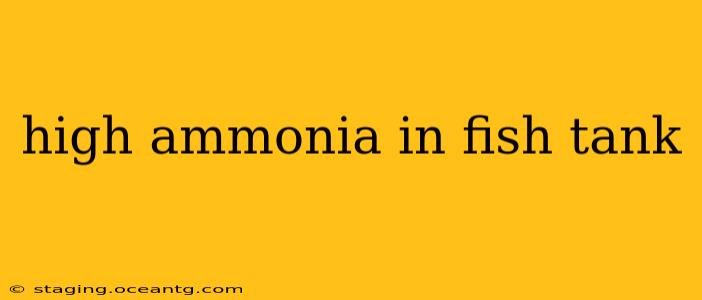High ammonia levels in a fish tank are a serious issue that can quickly lead to illness and death for your aquatic pets. Understanding the causes, recognizing the symptoms, and implementing effective solutions is crucial for maintaining a healthy and thriving aquarium environment. This comprehensive guide will walk you through everything you need to know about dealing with high ammonia in your fish tank.
What Causes High Ammonia in a Fish Tank?
High ammonia levels primarily stem from the breakdown of organic waste in your tank. This waste includes uneaten food, fish waste (feces and urine), decaying plant matter, and leftover food. Bacteria are responsible for breaking down this waste, but the process occurs in stages. Initially, ammonia is produced. Beneficial bacteria then convert ammonia into nitrite, and finally, into nitrate, which is less toxic. When the beneficial bacteria population is insufficient or overwhelmed, ammonia builds up.
Here are some key factors contributing to high ammonia:
- Overstocking: Too many fish in a tank produce more waste than the beneficial bacteria can handle.
- Overfeeding: Excess uneaten food quickly decomposes, releasing ammonia.
- Insufficient Filtration: A weak or inadequate filter cannot effectively remove ammonia and other harmful compounds.
- New Tank Syndrome (Nitrogen Cycle): In newly set up tanks, the beneficial bacteria colony hasn't had time to establish itself, leading to a build-up of ammonia.
- Filter Media Issues: Clogged or dirty filter media reduces its efficiency in removing ammonia.
- Sudden Temperature Changes: Dramatic temperature swings can harm beneficial bacteria.
- Medication: Certain fish medications can disrupt the nitrogen cycle.
What are the Symptoms of High Ammonia in a Fish Tank?
Recognizing the symptoms of high ammonia is critical for prompt action. These signs often manifest in your fish's behavior and appearance:
- Lethargy and Loss of Appetite: Fish appear listless and don't eat as much.
- Rapid Gill Movement: They struggle to breathe due to ammonia's irritation.
- Clamped Fins: Fins are held tightly against their bodies.
- Redness or Swelling of Gills and Fins: Inflammation is a common sign of ammonia poisoning.
- Excessive Slime Coat Production: An attempt by the fish to protect itself from the harmful effects of ammonia.
- Fish Hiding: Fish will often seek refuge in darker areas of the tank.
- Death: In severe cases, ammonia poisoning can lead to death.
How Do I Test for Ammonia in My Fish Tank?
Regular water testing is paramount. Use a reliable liquid test kit, as strip tests are less accurate. Test for ammonia, nitrite, and nitrate to get a complete picture of your tank's water parameters. Look for kits that test for the presence of ammonia (NH3) and ionized ammonia (NH4+), as both are toxic to fish.
How to Reduce High Ammonia Levels in My Fish Tank?
Addressing high ammonia levels requires a multi-pronged approach:
- Large Water Change: Perform a 25-50% water change immediately. Use dechlorinated water matched to the temperature of your tank.
- Improve Filtration: Ensure your filter is clean and working efficiently. Consider adding additional filtration if necessary.
- Reduce Feeding: Feed your fish less frequently and in smaller amounts.
- Check for Overstocking: If your tank is overstocked, consider rehoming some fish.
- Add Beneficial Bacteria: Introduce a commercially available product containing beneficial bacteria to jumpstart the nitrogen cycle. However, this isn't a magic fix and must be combined with other measures.
- Activated Carbon: Use activated carbon in your filter to help absorb ammonia. Remember to replace it regularly.
- Monitor Water Parameters: Continue testing regularly to monitor ammonia levels.
What is the Safe Ammonia Level in a Fish Tank?
The ideal ammonia level in a fish tank is 0 ppm (parts per million). Any detectable amount of ammonia is harmful to your fish.
How Long Does it Take to Fix High Ammonia Levels?
The time it takes to reduce high ammonia levels depends on the severity of the problem and the measures taken. It could take several days or even weeks to completely restore the nitrogen cycle and reach safe levels, especially in a new tank. Consistent monitoring and water changes are key.
Can High Ammonia Levels Hurt Humans?
While not as acutely toxic to humans as to fish, prolonged exposure to high ammonia levels can still cause skin irritation and respiratory problems. Always practice good hygiene when handling fish tank water and wear gloves when performing maintenance tasks.
By proactively monitoring water quality, addressing potential issues promptly, and understanding the nitrogen cycle, you can maintain a healthy and happy environment for your fish, minimizing the risk of high ammonia levels. Remember, prevention is always better than cure.
